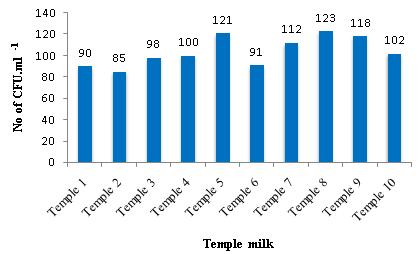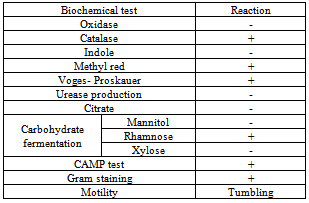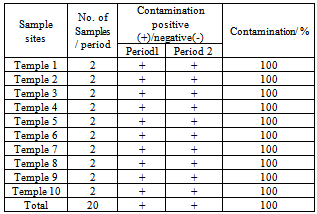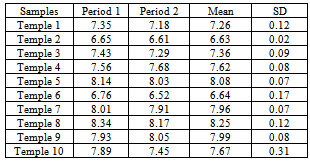-
Paper Information
- Next Paper
- Previous Paper
- Paper Submission
-
Journal Information
- About This Journal
- Editorial Board
- Current Issue
- Archive
- Author Guidelines
- Contact Us
Food and Public Health
p-ISSN: 2162-9412 e-ISSN: 2162-8440
2013; 3(2): 97-99
doi:10.5923/fph.20130302.03
Prevalence of Listeria monocytogenes in Temple Milks Offered to the Devotees as Sacred Liquid in Tiruchirappalli, Tamilnadu, India
Mariaselvam Sheela Mary, Nirmaladevi D Shrinithivihahshin
Department of Environmental Management, School of Environmental Sciences, Bharathidasan University, Tiruchirappalli, 620024, Tamil Nadu, India
Correspondence to: Nirmaladevi D Shrinithivihahshin, Department of Environmental Management, School of Environmental Sciences, Bharathidasan University, Tiruchirappalli, 620024, Tamil Nadu, India.
| Email: |  |
Copyright © 2012 Scientific & Academic Publishing. All Rights Reserved.
Investigation was carried out to test the occurrence of Listeria monocytogenes in the temple milk. L. monocytogenes is a pathogen that prevails in food and environmental samples. It can survive the extreme storage conditions. The pathogen can cause listeriosis disease which affect immunocompromised persons. In India, milk is used for abhishekam (an abhishekam is a religious bathing ceremony of the deity). Such milks are collected during the rituals and are offered to the devotees as a theertham (a sacred liquid, offered at temples to the worshipers); people have the faith that consuming theertham cures all their ailments. Milk samples were collected in two spells from ten randomly selected temples, situated in Tiruchirappalli city, Tamilnadu, India and the samples were investigated for the presence of the bacterium using NF EN ISO 11290-2 method. The results indicated that, all the samples were contaminated by the pathogen and the number exceeds the recent safety limit of the Indian food safety and regulation standards.
Keywords: L. monocytogenes, Safety of Milk, Temple Milk
Cite this paper: Mariaselvam Sheela Mary, Nirmaladevi D Shrinithivihahshin, Prevalence of Listeria monocytogenes in Temple Milks Offered to the Devotees as Sacred Liquid in Tiruchirappalli, Tamilnadu, India, Food and Public Health, Vol. 3 No. 2, 2013, pp. 97-99. doi: 10.5923/fph.20130302.03.
Article Outline
1. Introduction
- Milk contains pathogens like Salmonella enterica, Escherichia coli, Mycobacterium tuberculosis,Mycobacterium paratuberculosis, Brucella abortus, Coxiella burnetii, Yersinia enterocolitica, Staphylococcus aureus, Listeria monocytogenes etc. Of the various milk pathogens, L. monocytogenes is one of the deadly organisms occurs largely in all types of environment, including foods grown in contaminated environment, poorly processed/stored food, milk and associated products. The organism causes listeriosis to people who consume contaminated food, provided they lack immune power. The risk of being affected by listeriosis is more among the immunocompromised persons like pregnant women & their fetuses, children, AIDS affected individuals, TB & cancer-patients, diabetics and elderly people[1]. The infection is exhibited in the form of fever, abortion, still birth, brain damage and death depending upon the individual’s immune power and the nature of contamination. Average mortality rate caused by the pathogen is in adults 30-40%, neonates 50% and general hospitalization rate of the disease is 91%. Considering its pathogenesis and mortality rate among the infected individuals, the Indian government has recently included the organism in the food safety and regulations lists, in 2011[2]. In the earlier study, conducted by us, in Trichy district of Tamilnadu, India L. monocytogenes was found 100 % in the unpasteurised milk sold locally[3]. The findings of the study gave us insight for the present proposed work, because in India particularly in Tamilnadu, cow’s milk is preferred in fresh (without pasteurisation) largely for feeding the infants and performing temple rituals particularly for abishekam (‘abhishekam’ is a religious bathing ceremony of idols in the temples); such milks are consumed raw as theertham (a sacred liquid offered to devotees in temples for consumption) by the peoples of all ages, and hence quality of such milks need to be explored for microbial safety, before it affects large sector of people.
2. Materials and Methods
2.1. Study Area and Sample Collection
- The city, Tiruchirappalli, India houses with some marvellous temples and colonial churches, and also is a pilgrimage town. The major temples found in the city are the Rock Fort Temple, Sri Ranganathaswamy Temple, Tiruvanaikkaval Jambukeshwara Temple, Pallava Temple, Tirukkozhi Divya Desam, Sri Ranganatha Swami Temple, Samayapuram Mariamman Temple and Vayalur Skanda Temple. Ten Milk samples were collected from ten randomly selected temples at two different periods (including replicates).The temples included for the study are temples of Lord Ganesh, Muruga, Anjhneya, and Shakthi, located in BHEL, Milakuparrai, Airport, Palakarai, Karumandapam and Uraiyur. Samples were taken directly from the idol during the sacred bathing ceremony. The samples were brought to the laboratory keeping in ice-box (4°C) and assessed for L. monocytogenes and pH.
2.2. Isolation and Identification of L. monocytogenes
- Milk samples were initially homogenized for 3 min and the pH of the samples were measured using Elico LI 617® pH meter. About 25 ml of each samples were introduced separately in to the 500 ml conical flasks (Borosil) containing 225 ml of Buffered Peptone Water (pH7.2±0.2). After homogenization the samples were stored at room temperature for 1 h ± 5 min for enrichment of organisms which were previously under stressed condition. One ml of the sample from the enrichment buffer was poured into Petri plates in duplicates and the test organisms were allowed to culture on Polymixin Acryflavin Lithium chloride Ceftazidime Asculin Mannitol (PALCAM) (HIMEDIA®) agar and the plates were incubated at 37 ºC for 48h. Black colour colonies with grey centre were counted and further streaked onto Tripticase Soy Agar with Yeast extract (TSAY) (HIMEDIA®) as prescribed by NF EN ISO 11290-2[4].
2.2.1. Physiological and Biochemical Examination
- Four to five suspected colonies from each TSAY bacterial plate were picked, identified, sub cultured and purified. Gram staining and Motility tests were done. The presence of L. monocytogenes was confirmed through various biochemical tests such as Oxidase, Catalase, Indole, Methyl red, Voges-Proskauer, Urease production, Simmon’s citrate agar, and various sugar fermentation (Mannitol, Rahmnose and Xylose) and CAMP[5] tests (Table 1).
|
3. Results and Discussion
- In the present study, milk samples, collected from ten temples were examined for the presence of L. monocytogenes (Table 2). All the samples were found to contain L. monocytogenes ranging between 85 to 123 CFU/ml (Figure1).
|
 | Figure 1. The average occurrence of L. monocytogenes in the temple milks collected in two different periods |
|
4. Conclusions
- Severity of the pathogen in causing listeriosis perse is unknown by the public and the pathogenesis is normally misdiagnosed as streptococcal infection by the most of the physicians in the country and this is mainly due to the lack of much information about the organism as a food borne pathogen. Because in India the incidence of Listeriosis was less common in earlier days and came to light only after 1995.This is also one of the reason for the failure to act with the prudence in diagnosing the pathogenesis. By seeing the results of the present work it has been confirmed that the raw milk used in the abishekam are severely contaminated with the deadly pathogen and the load is above the safety limit i.e 100 CFU .ml-1. Since the temple milks are consumed raw, the study report would create awareness among the public and reveal the situation for making stringent regulations and guidelines for taking preventive measures to safe guard the lives of common public.
 Abstract
Abstract Reference
Reference Full-Text PDF
Full-Text PDF Full-text HTML
Full-text HTML

